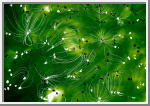|
COMETS EARTH JUPITER KUIPER BELT MARS MERCURY METEORITES NEPTUNE OORT CLOUD PLUTO SATURN SOLAR SYSTEM SPACE SUN URANUS VENUS ORDER PRINTS
PHOTO CATEGORIES SCIENCEVIEWS AMERICAN INDIAN AMPHIBIANS BIRDS BUGS FINE ART FOSSILS THE ISLANDS HISTORICAL PHOTOS MAMMALS OTHER PARKS PLANTS RELIGIOUS REPTILES SCIENCEVIEWS PRINTS
|
Related Document
Download Options
This image is a model of magnetic fields at the surface of the Sun developed using data from several instruments on board the ESA/NASA Solar and Heliospheric Observatory (SOHO) spacecraft. The data were taken on October 19, 1996. The green and white plane in the foreground is from the solar corona from the Extreme Ultraviolet Imaging Telescope (EIT) instrument. The solar corona is a region of hot, electrically charged gas streaming from the surface of the Sun. The image shows different amounts of coronal material at a temperature of about 2.7 million degrees Fahrenheit. Whiter areas represent more material at this temperature, darker areas represent less. The black and white spots represent magnetic field concentrations with opposite orientations, called polarity. Each spot is roughly 5,000 miles across. These concentrations make up the solar "magnetic carpet" that is believed to be responsible for the extreme heating of the corona. Between pairs of opposite polarity, magnetic field connections exist, represented here by lines based on computer calculations. These horseshoe shaped loops extend above the surface into the corona. Although small relative to the Sun, they range between a few thousand to several tens of thousands of miles in length; the smallest would still fit around the Earth. Each one of these loops carries as much energy as a large hydroelectric plant, such as the Hoover dam, would generate over a million years. |
